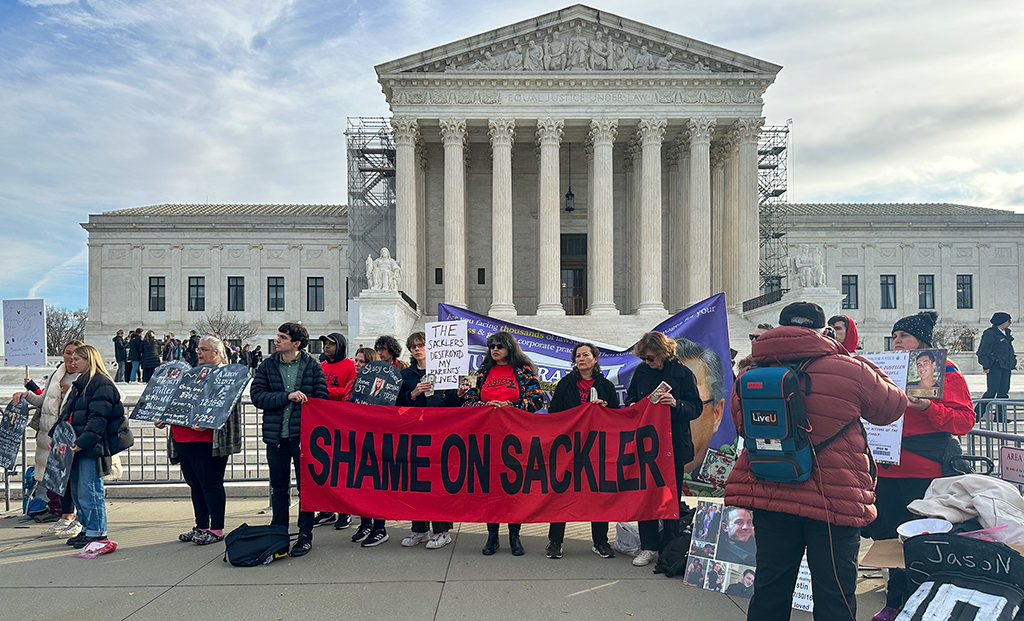WASHINGTON – Supreme Court justices appeared torn on whether Purdue Pharma’s bankruptcy settlement plan, which would protect the Sackler family ownership from civil liability in exchange for $6 billion in opioid relief funds, has legal standing during oral arguments on Monday.
Over 95% of the victims who brought lawsuits against Purdue, the developer of the highly addictive painkiller OxyContin, voted on the settlement to support the plan as it stands. Since OxyContin came on the market in 1996, over 645,000 people have died from opioid overdose.
“The billions of dollars that the plan allocates for opioid abatement and compensation will evaporate, creditors and victims will be left with nothing and lives literally will be lost,” warned Purdue’s lawyer Gregory Garre if the high court rules against the company.
Purdue, often credited with starting the lethal opioid epidemic, filed for bankruptcy in 2019 following thousands of civil lawsuits against the company and the Sacklers from states, hospitals and individuals affected by their addictive wonder pill. The lawsuits collectively sought over $40 trillion in damages. More than 130,000 plaintiffs, including individual victims and family members, have filed claims against Purdue and the Sacklers.
A bankruptcy court put lawsuits against Purdue and the Sacklers on hold and approved the company’s settlement in 2021. The plan would require the Sacklers to relinquish ownership of the company and contribute $6 billion of their own assets towards opioid recovery efforts.
The Department of Justice’s bankruptcy watchdog, the U.S. Trustee, asked the Supreme Court to take up the case. The federal government expressed concern that approval of Purdue’s plan would empower bankruptcy courts to issue blanket relief to responsible individuals via bankruptcy settlements.
At the core of Monday’s two-hour debate was whether the Bankruptcy Code, the federal law governing all bankruptcy cases, authorizes non-bankrupt individuals tied to a bankrupt party to escape legal liability via a bankruptcy settlement, as Purdue has outlined for the Sacklers.
Justices highlighted the “catchall” section of the Bankruptcy Code when probing both Purdue’s counsel and the trustee, which allows “any other appropriate provision” to be included in a settlement. Justices debated whether the term “appropriate” grants the broad authority to offer legal protections to the non-debtor Sacklers.
“It conflicts with the basic nuts and bolts of the Bankruptcy Code’s comprehensive scheme. It permits the Sacklers to decide how much they’re going to contribute,” said Curtis Gannon, a lawyer representing the U.S. Trustee.
Despite the vast majority of victims supporting the deal, Gannon and some justices expressed concern that without full consent, the liability release included in the current bankruptcy plan would infringe on the rights of victims who oppose the plan to sue the Sacklers.
“It would raise serious due process concerns,” Justice Neil Gorsuch said. Protesters outside the court, many of whom said they, too, were victims of Purdue’s opioid products and opposed the settlement, chanted, “Sacklers lie, people die.”
The court also weighed the importance of the Sacklers’ funds, noting that absent the current settlement, the wealthy family would not be required to contribute any of their own assets towards opioid recovery efforts.
“Your opening never mentioned the opioid victims. The opioid victims and their families overwhelmingly approve this plan because they think it will ensure prompt payment,” Justice Brett Kavanaugh said to Gannon.
“When thinking about the term ‘appropriate,’ I’m not sure why we should cast aside that concern so readily,” the justice added.
Justice Elena Kagan also expressed concern about how denying this settlement may contradict the basic purpose of bankruptcy law.
“You’re supposed to maximize the estate and you’re supposed to do things that will effectuate successful reorganizations,” Kagan said. “It seems as though the federal government is standing in the way of that.”
The ramifications of this case have heavy implications for both the opioid crisis and the future of such settlements.
“What I came to realize, throughout this whole process is that we’re not going to put the Sacklers in jail,” said Cheryl Juaire, who lost two of her children to opioid-related deaths and is a member of the trustee-appointed victims’ committee represented on Monday. The committee supports the Purdue settlement.
“And at this point in time in this epidemic, we need that $6 billion.”
Juaire founded Team Sharing, an organization that leads peer support groups for families who have lost loved ones to addiction. Juaire warned that without the settlement, individual victims and states will be pitted against each other to fight for remaining funds.
From a legal perspective, experts say this is the most significant bankruptcy case to come before the Supreme Court in the past 30 years.
“Implicit in that is this extremely powerful grant of essentially the power to create your own little bankruptcy process for non-debtors,” said Ralph Brubaker, a law professor at the University of Illinois College of Law. Brubaker, who filed a brief in support of the government, said the ruling will have an impact on the “larger systemic issue” of using the bankruptcy process as a way to escape liability.
Based on Monday’s discussion, experts note that the justices are grappling with the various intricacies and concerns surrounding both sides of a future decision.
“There were those justices that were skeptical that statutory authority exists for this dramatic use of the Bankruptcy Code and even wondering if there might be constitutional problems. And on the other hand, you have justices who are aware that reversing this case and preventing the kind of settlement we see here could have devastating implications for the victims,” Edward Morrison, a professor of law at Columbia Law School, said.
The court is expected to rule on the case by the summer of 2024 while Purdue, the Sacklers and victims await their fate.



